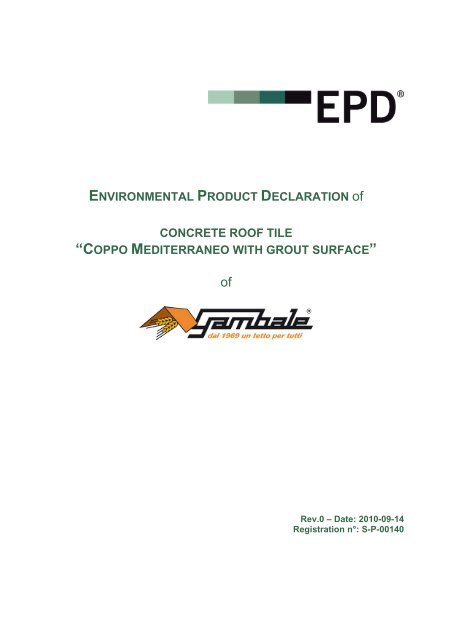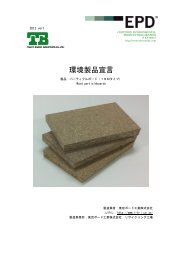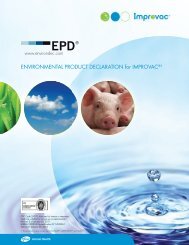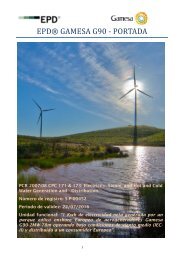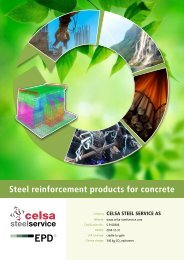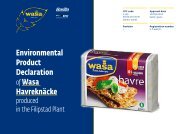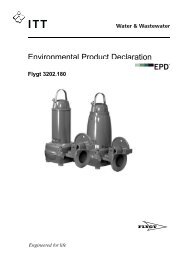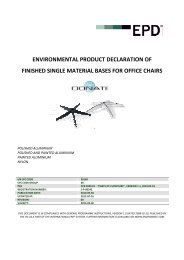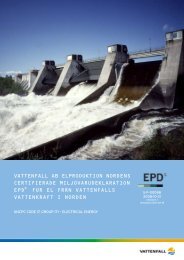concrete roof tile
concrete roof tile
concrete roof tile
Create successful ePaper yourself
Turn your PDF publications into a flip-book with our unique Google optimized e-Paper software.
ENVIRONMENTAL PRODUCT DECLARATION of<br />
CONCRETE ROOF TILE<br />
“COPPO MEDITERRANEO WITH GROUT SURFACE”<br />
of<br />
Rev.0 – Date: 2010-09-14<br />
Registration n°: S-P-00140
LIST OF CONTENTS<br />
1. ORGANIZATION AND PRODUCT DESCRIPTION...................................................................................................... 3<br />
1.1 Organization............................................................................................................................................ 3<br />
1.2 Product .................................................................................................................................................... 3<br />
1.3 Content declaration ................................................................................................................................. 4<br />
2. ENVIRONMENTAL PERFORMANCE DECLARATION................................................................................................. 4<br />
2.1 Methodology............................................................................................................................................ 4<br />
2.2 Functional Unit ........................................................................................................................................ 4<br />
2.3 System boundaries ................................................................................................................................. 4<br />
2.4 Data quality ............................................................................................................................................. 6<br />
2.5 Use phase informations .......................................................................................................................... 7<br />
2.6 End of life informations............................................................................................................................ 7<br />
2.7 Impact assessment ................................................................................................................................. 8<br />
2.7.1 Potential environmental impact of manufacturing phase................................................................ 8<br />
2.7.2 Resource use and waste generation of manufacturing phase ....................................................... 8<br />
2.7.3 Potential environmental impact, resource use and waste generation of distribution phase<br />
scenario .................................................................................................................................................... 9<br />
3. INFORMATION ABOUT ORGANIZATION AND CERTIFICATION BODY.......................................................................... 9<br />
3.1 Contacts .................................................................................................................................................. 9<br />
3.2 Other registrations of Organization ......................................................................................................... 9<br />
3.3 Certification body .................................................................................................................................. 10<br />
3.4 Other informations................................................................................................................................. 10<br />
3.5 References............................................................................................................................................ 10<br />
GLOSSARY ........................................................................................................................................................ 11<br />
Pag. 2 /11
1. ORGANIZATION AND PRODUCT DESCRIPTION<br />
1.1 Organization<br />
Gambale started colours <strong>concrete</strong> <strong>roof</strong> <strong>tile</strong>s production in 1969 using only 6 employees and a semi-automatic<br />
plant with a production capacity of 1000 <strong>roof</strong> <strong>tile</strong>s per hour. In 1974 we had a technological innovation with<br />
the acquisition of a new totally automatic plant with a production capacity of 2300 <strong>roof</strong> <strong>tile</strong>s per hour. Today<br />
the Gambale area is 50000 m 2 with 4 sheds for the complete production of the <strong>roof</strong> system. The production<br />
capacity is 64000 swages per day for <strong>concrete</strong> <strong>roof</strong> <strong>tile</strong>s.<br />
The Gambale system is certified ISO 9001. The <strong>concrete</strong> <strong>roof</strong> <strong>tile</strong>s have a quality label ISTEDIL (Istituto<br />
Sperimentale per l’Edilizia), the quality label EN 490 and they are under warranty for 30 year.<br />
1.2 Product<br />
Gambale produces 4 types of <strong>concrete</strong> <strong>roof</strong> <strong>tile</strong>s: Coppo Portoghese, Doppia Romana, Doppio Coppo and<br />
Coppo Mediterraneo. The EPD product is Coppo Mediterraneo made in grout surface and 2 different colors:<br />
Antica Toscana and Vecchio Piemonte (fig.1.1). In table 1.1 are described the technical data of <strong>concrete</strong> <strong>roof</strong><br />
<strong>tile</strong>.<br />
Fig.1.1- The Coppo Mediterraneo “Antica Toscana” and “Vecchio Piemonte”<br />
THECNICAL DATA<br />
Dimension cm. 42 x 33<br />
Width of covering cm. 30<br />
Weight per piece kg 4.8<br />
Weight per m 2 according to<br />
superposition<br />
Amount per m 2 according<br />
to superposition<br />
kg 44.65 ± 49.35<br />
9.5 ± 10.5<br />
Colours with grout surface<br />
Vecchio Piemonte<br />
Antica Toscana<br />
Tab.1.1- The technical data of <strong>concrete</strong> <strong>roof</strong> <strong>tile</strong><br />
The <strong>concrete</strong> <strong>roof</strong> <strong>tile</strong>s are tested according to UNI EN 490:2005 and UNI EN 491:2005 which guarantee the<br />
water impermeability, resistance to freezing cold, resistance to thaw and ultimate strength.<br />
Pag. 3 /11
1.3 Content declaration<br />
In tab.1.2 are described information about content declaration of material and chemical substance in the<br />
product life cycle.<br />
MATERIAL/ SUBSTANCE CAS-NUMBER ENVIRONMENTAL<br />
CLASS<br />
HEALTH-CLASS<br />
COMPONENTS CEMENTS 65997-15-1 no<br />
R36/37/38 R43<br />
INERTS<br />
no<br />
PERCENTAGE (%) OF MATERIALS<br />
AND SUBSTANCES TOTAL WEIGHT<br />
no 99.53<br />
INORGANIC PIGMENTS 1309-37-1<br />
1317-61-9<br />
no<br />
no<br />
51274-00-1<br />
0.035<br />
ACRYLIC ADDITIVES 111-76-2 no R 20/21/22. R 36/38 0.322<br />
LUBRICANTS AND OILS - 1<br />
- 1<br />
- 1 0.103<br />
64742-47-8 no<br />
R65, R66<br />
PACKAGING no no no 0.01<br />
TOTAL 100<br />
Tab.1.2- Content declaration of <strong>concrete</strong> <strong>roof</strong> <strong>tile</strong> [% for 1 t of <strong>tile</strong>]<br />
Some materials and substances listed in tab.1.2 contain percentages of dangerous substances, which are in<br />
such concentrations to be at the limit allowed by the Substances and Preparations Directive 2 .<br />
2. ENVIRONMENTAL PERFORMANCE DECLARATION<br />
2.1 Methodology<br />
The methodology used for environmental performance calcultation is the Life Cycle Assessment (LCA),<br />
according to ISO 14040:2006 and ISO 14044:2006. The characterization factors in Appendix A of<br />
Requirements for Environmental Product Declarations, EPD MSR 1999:2, Swedish Environmental<br />
Management Council 2000-03-27, have been used to make the Life Cycle Impact Assessment (LCIA) phase.<br />
2.2 Functional Unit<br />
The functional unit (FU) is 1 tonne (t) of selling (production capacity – scraps production) Coppo<br />
Mediterraneo with grout surface <strong>concrete</strong> <strong>roof</strong> <strong>tile</strong>, produced in 2009 in the Gambale site, Mirabello (Ferrara,<br />
Italy).<br />
2.3 System boundaries<br />
The system boundaries (figure 2.1) consist from the extraction of raw material, the transformation and<br />
transport to final product distribution to customers. The product manufacturing includes the following phases:<br />
the supplying raw materials, materials and additives; the blending to getting the <strong>concrete</strong>; the press-<br />
1<br />
Data lacking.<br />
2<br />
Council Directive 76/769/EEC of 27 July 1976 on the approximation of the laws, regulations and administrative provisions of the<br />
Member States relating to restrictions on the marketing and use of certain dangerous substances and preparations, and subsequent<br />
amendments. European legislation. In Italy: D.M. 10/05/2004 “Recepimento della Direttiva 2003/53/CE recante la XXVI modifica alla<br />
Direttiva 76/769/CEE del Consiglio del 27 luglio 1976, relativa alle restrizioni in materia di immissione sul mercato e di uso di talune<br />
sostanze e preparati pericolosi”.<br />
Pag. 4 /11
extrusion; the grouting; the resin application; the natural drying; the <strong>roof</strong> <strong>tile</strong>s collection (swages removal);<br />
the packing and the stocking; the ordinary maintenance. For the LCA study it has been created a model to<br />
schematize life cycle of <strong>concrete</strong> <strong>roof</strong> <strong>tile</strong> and as follows:<br />
MANUFACTURING PHASE:<br />
- Blend preparation (extraction of raw materials and supplying materials)<br />
- Grout preparation (extraction of raw materials and supplying materials)<br />
- Ancillary materials (supplying additive materials)<br />
- Energy consumptions (aggregate for all manufacturing phases)<br />
- Fuel consumption for handling goods<br />
- Packagings (supplying plastic bands)<br />
- Ordinary maintenance (supplying lubricating materials)<br />
DISTRIBUTION PHASE:<br />
- Product distribution from Gambale plant to costumers.<br />
Since the transport distance doesn’t depends by the manufacturers but by the purchasers location and this<br />
varies during the time, the result in the impact assessment is indicated for the generic distance of 100 km<br />
(section 2.7.3).<br />
Pag. 5 /11
EXTRACTION RAW MATERIALS<br />
AND SUPPLYING MATERIALS<br />
Transport<br />
BLENDING<br />
MANUFACTURING<br />
PAHSE<br />
PRESS-EXSTRUSION<br />
GROUTING<br />
INPUT<br />
RESOURCES<br />
ENERGIES<br />
TRANSPORTS<br />
RESIN APPLICATION<br />
NATURAL DRYING<br />
SWAGES REMOVAL<br />
OUTPUT<br />
WASTES<br />
EMISSIONS TO AIR,<br />
WATER AND SOIL<br />
PACKING AND STOCKING<br />
DISTRIBUTION<br />
USE<br />
PHASE<br />
USE AND END OF LIFE<br />
Not included in the impact assessment<br />
Fig.2.1- The system boundaries of life cycle <strong>concrete</strong> <strong>roof</strong> <strong>tile</strong><br />
Exclusions<br />
As set out in the PCR 2008:04, the following processes are not included: the construction of factory buildings<br />
and infrastructure; the production of manufacturing equipment; the maintenance and production of spare<br />
parts which have a life cycle longer than three years (e.g. the aluminium swages); the packaging of raw<br />
materials; the personnel activities.<br />
In addition, the following processes are not included: product use by costumers (described in qualitative<br />
terms in paragraph 2.5); product end of life treatments (described in qualitative terms in paragraph 2.6).<br />
2.4 Data quality<br />
The data used for the LCA study are collected in the Gambale production site and site-specific data provided<br />
by Gambale according to 2009. The data of database used for impact assessment are: Ecoinvent 1.2, ETH-<br />
ESU 96, IVAM LCA 3, BUWAL 250 e IDEMAT 2001.<br />
The electricity mix used by Gambale is the Italian one (in LCA study it has been considered the italian mix<br />
electricity of Ecoinvent database).<br />
Pag. 6 /11
For the transports representation (from supplying firms to Gambale and from Gambale to costumers) it has<br />
been used the actual transportation model present in Ecoinvent 1.2, ETH-ESU 96 and IDEMAT 2001<br />
database. The veicule types and the distances are based on real data provided by Gambale and supplying<br />
firms.<br />
According to the Requirements for Environmental Product Declarations (MSR 1999:2), the environmental<br />
impact associated to generic data don’t exceed 10% of the overall environmental impact due to the Gambale<br />
product system (they are ≤ 1%).<br />
2.5 Use phase informations<br />
Generally, the <strong>concrete</strong> <strong>roof</strong> <strong>tile</strong> use phase includes: building site operations and security plans for height<br />
works; the covering scheme; the laying of elements for <strong>roof</strong> covering impermeability; the covering<br />
maintenance. All these aspects are very significant for the <strong>roof</strong> durability. The durability is an important<br />
building characteristic because it permits to last long and have the best performances as long as possible.<br />
The durability dependes on: material quality; the techniques layed to installation and weather events to which<br />
<strong>roof</strong> covering is subject 3 . The Gambale <strong>concrete</strong> <strong>roof</strong> <strong>tile</strong>s are under warranty for 30 years and they have a<br />
durability as building ones (i.e. 80 or 100 years). Gambale provides assistance to operators during <strong>roof</strong><br />
covering design, it provides assistance for laying techniques and for technical solutions in order to preserve<br />
the <strong>roof</strong> covering characteristic in serious weather events (e.g. hail, water seepage and freezing).<br />
2.6 End of life informations<br />
It is considered very important to communicate which can be the <strong>concrete</strong> <strong>roof</strong> <strong>tile</strong> disposal scenarios, within<br />
environmental in force legislation, in order to follow the best available technology (BAT) promoting the end of<br />
life treatments for recovery or recycling material instead of disposal in landfills. In fact, Gambale recovers<br />
all the <strong>concrete</strong> <strong>roof</strong> <strong>tile</strong>s scraps. One of the main characteristics of <strong>concrete</strong> <strong>roof</strong> <strong>tile</strong>s is that they can be<br />
completely reusable, after crushing, as inert in other manufacturing and/or product. This aspect facilitates<br />
the spread of criteria for selective buildings demolition. The selective building demolition method enables<br />
separation of different building components (e.g. the <strong>concrete</strong>) through techniques aimed at obtaining<br />
homogeneous material fractions reusable again. It is advisable to include in product design phase the<br />
material recovery and recycling scenarios and include in the end of life phase the techniques to separate<br />
materials recovered. The waste of <strong>concrete</strong> <strong>roof</strong> <strong>tile</strong>, according to environmental italian legislation, is<br />
identified as “special waste non-hazardous” and it is a waste that derives from “construction and demolition<br />
waste” (C&D). According to italian annual statistics 4 the “C&D wastes” are recovered for 56.3%.<br />
3<br />
Source: C.Pellanda, “La manutenzione delle coperture”, Il Tetto, informazione, cultura e tecnica edilizia. Marzo 2006, n°84.<br />
4<br />
Source: Rapporto rifiuti 2007 -Estratto- APAT, Agenzia per la Protezione dell’Ambiente e per i servizi Tecnici, Gennaio 2008.<br />
Pag. 7 /11
2.7 Impact assessment<br />
2.7.1 Potential environmental impact of manufacturing phase<br />
Table 2.1 illustrates the potential environmental impact of 1 t (functional unit) of <strong>concrete</strong> <strong>roof</strong> <strong>tile</strong> life cycle in<br />
the manufacturing phase, in terms of the environmental impact categories, according to PCR 2008:04:<br />
Global warming (kg CO 2 eq), Ozone depletion (kg CFC-11 eq.), Photochemical oxidation (kg C 2 H 4 eq),<br />
Eutrophication (kg O 2 ), Acidification (kmol H+ eq.).<br />
POTENTIAL ENVIRONMENTAL IMPACT<br />
IMPACT CATEGORY UNIT TOTAL MANUFACTURING PHASE<br />
GLOBAL WARMING (GWP100) kg CO 2 eq 253<br />
OZONE LAYER DEPLETION (ODP) kg CFC-11 eq 1.3·10 -5<br />
PHOTOCHEMICAL OXIDATION kg C 2 H 4 eq 0.02<br />
EUTROPHICATION kg O 2 3.1<br />
ACIDIFICATION kmol H+ eq 0.02<br />
Tab.2.1- Potential environmental impact of LCA <strong>concrete</strong> <strong>roof</strong> <strong>tile</strong> [FU: 1 t of <strong>roof</strong> <strong>tile</strong>s]<br />
2.7.2 Resource use and waste generation of manufacturing phase<br />
Tables 2.2 and 2.3, describe results concerning to resource use (renewable and non-renewable with and<br />
without energy content) and wastes, generated by 1 t of <strong>concrete</strong> <strong>roof</strong> <strong>tile</strong> life cycle in the manufacturing<br />
phase.<br />
RESOURCES USE WITH ENERGY CONTENT [kg]<br />
TOTAL MANUFACTURING PHASE<br />
TOTAL NON RENEWABLE 5 41.5<br />
TOTAL RENEWABLE 6 0.5<br />
ENERGY CONTENT OF RESOURCES USED [MJ]<br />
TOTAL MANUFACTURING PHASE<br />
TOTAL NON RENEWABLE 1575<br />
TOTAL RENEWABLE 7 100<br />
DIRECT ELECTRICITY CONSUMPTION 68.7<br />
RESOURCES USE WITHOUT ENERGY CONTENT [kg]<br />
TOTAL MANUFACTURING PHASE<br />
TOTAL NON RENEWABLE 1161<br />
TOTAL RENEWABLE 8 524699<br />
Tab.2.2- Resources use with energy content [kg for 1 t of <strong>roof</strong> <strong>tile</strong>s]; Energy content of resources used [MJ for 1 t of <strong>roof</strong><br />
<strong>tile</strong>s]; Resources use with energy content [kg for 1 t of <strong>roof</strong> <strong>tile</strong>s].<br />
WASTES GENERATION [kg]<br />
TOTAL MANUFACTURING PHASE<br />
HAZARDOUS 4·10 -3<br />
OTHERS 33.3<br />
Tab.2.3- Wastes generation [kg for 1 t of <strong>roof</strong> <strong>tile</strong>s]<br />
5<br />
Coal, gas, oil, peat, uranium.<br />
6<br />
Wood.<br />
7<br />
Energy from: hydro power, biomass, wind, barrage water, solar.<br />
8<br />
Water.<br />
Pag. 8 /11
2.7.3 Potential environmental impact, resource use and waste generation of distribution phase<br />
scenario<br />
Tables 2.4 and 2.5, describe results concerning to potential environmental impact, resource use (renewable<br />
and non-renewable with and without energy content) and wastes, generated by 1 t of <strong>concrete</strong> <strong>roof</strong> <strong>tile</strong> life<br />
cycle in the distribution phase scenario.<br />
SCENARIO FOR 100 km<br />
POTENTIAL ENVIRONMENTAL IMPACT –DISTRIBUTION PHASE-<br />
IMPACT CATEGORY UNIT TOTAL DISTRIBUTION PHASE<br />
GLOBAL WARMING (GWP100) kg CO 2 eq 21.8<br />
OZONE LAYER DEPLETION (ODP) kg CFC-11 eq 3.2·10 -6<br />
PHOTOCHEMICAL OXIDATION kg C 2H 4 eq 8,4·10 -4<br />
EUTROPHICATION kg O 2 1.2<br />
ACIDIFICATION kmol H+ eq 5·10 -3<br />
Tab.2.4- Potential environmental impact of LCA <strong>concrete</strong> <strong>roof</strong> <strong>tile</strong> distribution phase [FU: 1 t of <strong>roof</strong> <strong>tile</strong>s]<br />
SCENARIO FOR 100 km<br />
RESOURCES USE AND WASTES -DISTRIBUTION PHASE-<br />
RESOURCES USE WITH ENERGY CONTENT RESOURCES USE WITHOUT ENERGY CONTENT<br />
WASTES GENERATION<br />
UNIT TOTAL UNIT TOTAL UNIT TOTAL<br />
NON<br />
RENEWABLE kg 8.18<br />
NON<br />
RENEWABLE kg 27.3 HAZARDOUS kg 1·10 -3<br />
RENEWABLE kg 0.03 RENEWABLE kg 30832 OTHERS kg 2.36<br />
Tab.2.5- Resource use renewable and non-renewable with and without energy content, wastes generation, in the<br />
distribution phase scenario for 100 km [kg for 1t of <strong>roof</strong> <strong>tile</strong>s]<br />
3. INFORMATION ABOUT ORGANIZATION AND CERTIFICATION BODY<br />
3.1 Contacts<br />
- Gambale Srl.: C.so Italia 538, 44043 Mirabello (FE) – Phone (+39) 0532-849714. Fax. (+39) 0532-<br />
849545. Web-site: http://www.gambaletegole.com. E-mail: info@gambaletegole.com. Referring:<br />
Stefano Gambale.<br />
- LCA technical support: LCA-lab Srl, Spin off ENEA - c/o ENEA (Italian National Agency for New<br />
Technologies, Energy and Sustainable Economic Development), Via Martiri di Montesole 4, Bologna,<br />
Italy – Phone (+39) 051-6098607/518. E-mail: info@lca-lab.com.<br />
3.2 Other registrations of Organization<br />
- Quality management system: ISO 9001:2000 (n°4421), approved by Certiquality.<br />
Pag. 9 /11
- Quality label ISTEDIL (Istituto Sperimentale per l’Edilizia).<br />
- Quality label DIN EN 490:2005-03 approved by Güteschutz Beton (Düsseldorf).<br />
3.3 Certification body<br />
The present EPD and associated Life Cycle Assessment have been approved by the accredited Certification<br />
body Certiquality, in accordance with MSR 1999:2 provided by the Swedish Environmental Management<br />
Council.<br />
Valid up to 17 September 2011.<br />
3.4 Other informations<br />
This EPD is a result of a project started in partnership with the Associazione Produttori Tegole in Cemento<br />
(APTC) (Association of the Manufacturers Cement Roof Tiles) in order to develop the environmental<br />
sustainability among organizations associated and promote the diffusion of Environmental Product<br />
Declaration for <strong>concrete</strong> <strong>roof</strong> <strong>tile</strong> product category.<br />
This EPD and further related information are available in website: www.environdec.com.<br />
The specific PCR for this category of products are PCR 2008:04, Product Category Rules (PCR) for<br />
Concrete <strong>roof</strong> coverings, <strong>concrete</strong> <strong>roof</strong> <strong>tile</strong>s and <strong>concrete</strong> complementary of the <strong>roof</strong> system, Version 1.0<br />
2008-06-16 and these are consultable in website www.environdec.com.<br />
3.5 References<br />
- ISO 14050:2002, Environmental management- Vocabulary.<br />
- P.Neri, G.Olivieri “Analisi del ciclo di vita (LCA) della tegola in calcestruzzo Coppo Mediterraneo con<br />
superficie boiaccata di Gambale Srl ai fini della certificazione EPD. Revisione dati 2010”, LCA-lab SRL,<br />
doc. RT-45_Rev.00, 13/09/10, pp.1-44, Bologna, Italy.<br />
- PCR 2008:04, Product Category Rules (PCR) for preparing an Environmental Product Declaration<br />
(EPD) for Concrete <strong>roof</strong> coverings, <strong>concrete</strong> <strong>roof</strong> <strong>tile</strong>s and <strong>concrete</strong> complementary of the <strong>roof</strong> system,<br />
Version 1.0 2008-06-16, the Swedish Environmental Management Council, available on<br />
www.environdec.com<br />
- Requirements for Environmental Product Declarations, EPD (MSR 1999:2), published by the Swedish<br />
Environmental Management Council.<br />
- Requirements for an International EPD Scheme, LIFE INTEND (LIFE 03 ENV/IT/000324) Version 1.0,<br />
June 2005.<br />
Pag. 10 /11
GLOSSARY<br />
Allocation: Partitioning the input or output flows of a process or other product system to the product system under study<br />
Acidification: Change in an environment's natural chemical balance caused by an increase in the concentration of<br />
acidic elements.<br />
CAS-number: CAS registry numbers are unique numerical identifiers for chemical compounds, polymers, biological<br />
sequences, mixtures and alloys. Chemical Abstracts Service (CAS), a division of the American Chemical Society,<br />
assigns these identifiers to every chemical that has been described in the literature. The intention is to make database<br />
searches more convenient, as chemicals often have many names. Almost all molecule databases today allow searching<br />
by CAS number.<br />
Characterization factor: Factor derived from a characterization model that is applied to convert the assigned LCI results<br />
to the common unit (allows aggregation into category indicator result) of the category indicator.<br />
Data quality: Characteristics of data that bear on their ability to satisfy stated requirements.<br />
Eutrophication: Excessive enrichment of waters with nutrients, and the associated adverse biological effects.<br />
Functional Unit: Quantified performance of a product system for use as a reference unit.<br />
Global warming: Changes in the surface-air temperature, referred to as the global temperature, brought about by the<br />
greenhouse effect which is induced by emission of greenhouse gases into the air.<br />
Input: Material or energy, which enters a unit process.<br />
Impact category: Class representing environmental issues of concern to which LCI results may be assigned.<br />
Life Cycle Assessment (LCA): Compilation and evaluation of the inputs, outputs and the potential environmental<br />
impacts of a product system throughout its life cycle.<br />
Life Cycle Impact Assessment (LCIA): Phase of life cycle assessment aimed at understanding and evaluating the<br />
magnitude and significance of the potential environmental impacts of a product system.<br />
Life Cycle Inventory analysis (LCI): A phase of life cycle assessment involving the compilation and quantification of<br />
inputs and outputs, for a given product system throughout its life cycle.<br />
Life Cycle Inventory results: A list of emissions, resource uses, land use, etc. that are collected, before impact<br />
assessment is applied.<br />
Output: Material (may include raw materials, intermediate products, co-products, products and releases) or energy that<br />
leaves a unit process.<br />
Ozone layer depletion: The fragile shield of ozone is being damaged by chemicals released on earth. The main<br />
chemicals that are depleting stratospheric ozone are chlorofluorocarbons which are used in refrigerators, aerosols, and<br />
as cleaners in many industries, and halons, which are used in fire extinguishers.<br />
Photochemical oxidation: A combination of fog and chemicals that come from automobile and factory emissions and is<br />
acted upon by the action of the sun.<br />
Product Category Rules (PCR): Technical information documents that define the rules to be adopted for the<br />
preparation of LCA and EPD in order to compare specific homogeneous category of products/services.<br />
Process: Set of interrelated or interacting activities that transforms inputs into outputs.<br />
Product: Any goods or service<br />
Product system: Collection of unit processes with elementary and product flows, performing one or more defined<br />
functions, that models the life cycle or a product.<br />
Raw material: primary or secondary material that is used to produce a product<br />
System boundary: A set of criteria specifying which unit processes are part of a product system<br />
Unit process: Smallest element of a product system for which data are collected when performing a life cycle<br />
assessment.<br />
Pag. 11 /11


